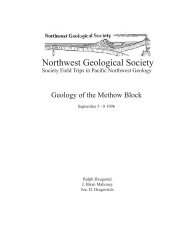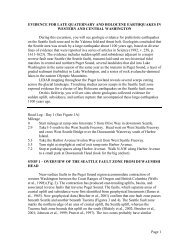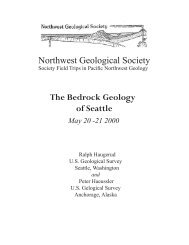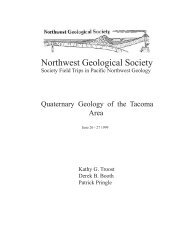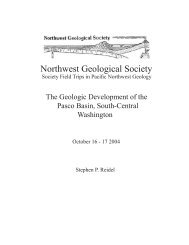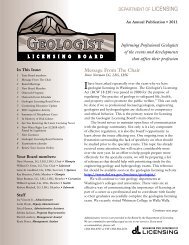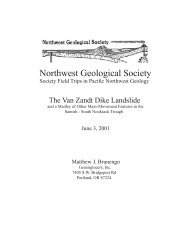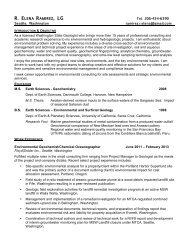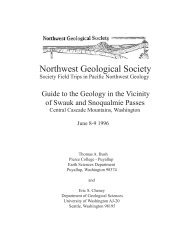The Geology of Quartz Creek - Nwgs.org
The Geology of Quartz Creek - Nwgs.org
The Geology of Quartz Creek - Nwgs.org
Create successful ePaper yourself
Turn your PDF publications into a flip-book with our unique Google optimized e-Paper software.
Northwest Geological Society<br />
Society Field Trips in Pacific Northwest <strong>Geology</strong><br />
<strong>The</strong> <strong>Geology</strong> <strong>of</strong> <strong>Quartz</strong> <strong>Creek</strong>:<br />
Plutons, Copper Mineralization, and Alteration <strong>of</strong><br />
the Snoqualmie Batholith, Cascade Range,<br />
Washington<br />
November 9, 1999<br />
Eric S. Cheney<br />
Department <strong>of</strong> Geological Sciences<br />
University <strong>of</strong> Washington AJ-20<br />
Seattle, Washington 98195
This field trip guide has been re-formatted from the<br />
original document produced by the author. All the<br />
original text and illustrations are reproduced here,<br />
and nothing has been added to the document in this<br />
process. All figures and images are reproduced at<br />
the same size as in the original document.<br />
NWGS Field Guides are published by the Society<br />
with the permission <strong>of</strong> the authors, permission<br />
which is granted for personal use and educational<br />
purposes only. Commercial reproduction and sale<br />
<strong>of</strong> this material is prohibited. <strong>The</strong> NWGS assumes<br />
no responsibility for the accuracy <strong>of</strong> these guides,<br />
or for the author’s authority to extend permission<br />
for their use.<br />
Of particular note, some stops on these trips may<br />
be located on private property. Publication <strong>of</strong> this<br />
guide does not imply that public access has been<br />
granted to private property. If there is a possibility<br />
that the site might be on private property, you<br />
should assume that this is the case. Always ask<br />
permission before entering private property.
<strong>The</strong> <strong>Geology</strong> <strong>of</strong> <strong>Quartz</strong> <strong>Creek</strong>:<br />
Plutons, Mineralization and Alteration <strong>of</strong> the Snoqualmie Batholith<br />
Cascade Range, Washington<br />
Eric S. Cheney<br />
University <strong>of</strong> Washington<br />
TABLE OF CONTENTS<br />
ABSTRACT<br />
INTRODUCTION<br />
PURPOSE<br />
ITINERARY<br />
PORPHYRY ORE DEPOSITS<br />
HISTORY OF QUARTZ CREEK<br />
REGIONAL GEOLOGY<br />
STRATIGRAPHY AND STRUCTURE<br />
SNOQUALMffi BATHOLITH<br />
BATHOLITHIC GEOLOGY AT QUARTZ CREEK..<br />
INTRODUCTION<br />
HORNFELS<br />
PREACHER MOUNTAIN QUARTZ<br />
MONZONITE<br />
QUARTZ CREEK QUARTZ DIORITE<br />
MAIN PHASE QUARTZ DIORITE<br />
UNNAMED BIOTITIC QUARTZ MONZONITE<br />
HYDROTHERMAL ALTERATION<br />
INTRODUCTION<br />
BIOTITIC ALTERATION<br />
MAFIC-DESTRUCTIVE ALTERATIONS<br />
CHLORTTIC ALTERATION<br />
SUMMARY<br />
HYDROTHERMAL MINERALIZATION<br />
STRUCTURE<br />
PLEISTOCENE GEOLOGY<br />
SUPERGENE ENRICHMENT<br />
TYPES OF PORPHYRY ORE DEPOSITS<br />
EVALUATION<br />
SUMMARY<br />
REFERENCES
ABSTRACT<br />
Porphyry ore deposits are submagmatic, disseminated zones <strong>of</strong><br />
mineralization related to the tops <strong>of</strong> porphyritic felsic plutons. Porphyry<br />
copper mineralization and alteration (CMA) at <strong>Quartz</strong> <strong>Creek</strong><br />
are superimposed on four igneous phases in the western part <strong>of</strong> the<br />
Miocene Snoqualmie batholith. Because the effects <strong>of</strong> weathering are<br />
minuscule and the rocks are mostly medium-grained, <strong>Quartz</strong> <strong>Creek</strong><br />
provides an unusual opportunity to study batholithic rocks and CMA.<br />
<strong>The</strong> major host for CMA is the medium-grained, equigranular,<br />
hornblende- and biotite-bearing <strong>Quartz</strong> <strong>Creek</strong> quartz diorite and its<br />
xe-nolithic, aphanitic to porphyritic border phase. Whatever pluton<br />
generated CMA is at some unknown depth. CMA is “inside-out”<br />
with respect to most porphyry copper deposits: per¬vasive biotitic<br />
alteration grades outward into fresh rock. <strong>The</strong> zone <strong>of</strong> biotitic alteration<br />
is elongate to the northwest (> 8400 feet) and open to the southeast,<br />
2000 feet wide, and exposed over 1500 feet vertically. Magnetite<br />
in the outer part <strong>of</strong> the zone grades inward to pyrite, chalcopyrite,<br />
and molybdenite.<br />
Superimposed on and inside the biotitic al¬teration is an irregular<br />
zone <strong>of</strong> chloritic alteration centered on two zones <strong>of</strong> quartz-sericitepyrite<br />
alteration (QSP). <strong>The</strong> QSP, with chalcopyrite and tourmaline,<br />
is superimposed on two biotitically altered breccia pipes. <strong>The</strong> two<br />
QSP zones are < 450 feet by 200 feet (elongate to the NNE). <strong>The</strong><br />
eastern pipe was drilled to a depth <strong>of</strong> 763 feet. In the eastern pipe,<br />
QSP also replaces andalusite and pyrrhotite. Pyrite dominates the<br />
eastern pipe; whereas, arsenopyrite dominates the western pipe.<br />
<strong>Quartz</strong> <strong>Creek</strong> is a quartz-dioritic, batholithic, copper-molybdenum<br />
representative <strong>of</strong> porphyry ore deposits. It is similar to the quartz<br />
monzo-nitic, batholithic, copper-molybdenum deposit at Butte,<br />
Montana. <strong>Quartz</strong> <strong>Creek</strong> was last explored in the mid-1960s before<br />
models <strong>of</strong> porphyritic or batholithic deposits were well known. Steep<br />
topography, lack <strong>of</strong> weathering, the low grade and tonnage <strong>of</strong> mineralized<br />
rock at the surface, and a potentially hostile political climate<br />
deter development.
INTRODUCTION<br />
PURPOSE<br />
This field trip inspects several igneous phases <strong>of</strong> the mid-Miocene<br />
Snoqualmie Batholith at the <strong>Quartz</strong> <strong>Creek</strong> copper prospect<br />
in the western part <strong>of</strong> the batholith and examines the hydrothermal<br />
alteration and mineralization at the prospect. Lack <strong>of</strong><br />
weathering, the generally medium-grained size <strong>of</strong> the intrusive<br />
rocks, and easy access make <strong>Quartz</strong> <strong>Creek</strong> an ideal place to<br />
observe the effects <strong>of</strong> magmatic and hydrother-mal processes.<br />
ITINERARY<br />
<strong>The</strong> <strong>Quartz</strong> <strong>Creek</strong> copper prospect is about 36 miles (58 km)<br />
east <strong>of</strong> Seattle in the Snoqualmie batholith. Specifically, most<br />
<strong>of</strong> the prospect is in N/2 Section 16 <strong>of</strong> T24N, R1OE; this area is<br />
on the Lake Phillippa (1989) 1:24,000 USGS topographic map.<br />
<strong>The</strong> first stop <strong>of</strong> the trip is the Snoqualmie Winery for an overview<br />
<strong>of</strong> the regional geology (Figure 1). To reach the winery<br />
take Exit 27 (eastbound) <strong>of</strong>f Interstate 90; no corresponding<br />
westbound exists. At the exit turn right and follow the road<br />
around to the left for about 1/3 mile to the gate <strong>of</strong> the winery.<br />
<strong>The</strong> view eastward from the winery is approximately along the<br />
arrow in Figure 1 that labels the Snoqualmie batholith. <strong>The</strong><br />
most conspicuous geomorphic features are the flat-topped<br />
remnants <strong>of</strong> the lateral moraine <strong>of</strong> the Puget lobe that advanced<br />
up the South Fork <strong>of</strong> the Snoqualmie River (the route<br />
<strong>of</strong> 1-90) and up the Middle Fork (the site <strong>of</strong> <strong>Quartz</strong> <strong>Creek</strong>).<br />
<strong>The</strong> crest <strong>of</strong> the moraine is 1680 feet; whereas, the valley in<br />
front is 600 feet. <strong>The</strong> ice and moraine dammed lakes in both<br />
the South and Middle Forks <strong>of</strong> the Snoqualmie.<br />
Access to <strong>Quartz</strong> <strong>Creek</strong> is from Exit 34 <strong>of</strong> I-90. From this<br />
exit proceed north about 13.0 miles on 468th Ave. SE, SE<br />
Middle Fork Road, and the Taylor River Road to the bridge<br />
on the Taylor River at the present end <strong>of</strong> the road.<br />
<strong>The</strong> main part <strong>of</strong> the trip is a five-mile (round-trip) walk<br />
(over 95% on logging roads) from the bridge up the valley<br />
<strong>of</strong> <strong>Quartz</strong> <strong>Creek</strong>. <strong>The</strong> maximum vertical ascent <strong>of</strong> this walk<br />
is 1400 feet. This part <strong>of</strong> the trip will take four or five hours.<br />
Bring your lunch (and rain gear?). Specific stops are neither<br />
described nor shown, but can be located on the accompanying<br />
maps.<br />
Figure 1. REGIONAL GEOLOGY OF CENTRAL WASHINGTON.<br />
<strong>The</strong> Snoqualmie batholith is the southern portion <strong>of</strong> the indicated area labeled OMi (see Fig. 3). Modified from Cheney (1994, fig. 10).
PORPHYRY ORE DEPOSITS<br />
Because <strong>Quartz</strong> <strong>Creek</strong> is a porphyry copper deposit, a brief<br />
review <strong>of</strong> that kind <strong>of</strong> ore deposit may be useful (cf. Titley and<br />
Beane, 1981). Porphyry ore deposits are zones <strong>of</strong> disseminated,<br />
post-magmatic (i.e., hydrothermal) mineralization related to<br />
the tops <strong>of</strong> felsic intrusions. <strong>The</strong>y are disseminated in the sense<br />
that individual mineralized structures are too small or narrow to<br />
mine individually and, thus, the entire zone <strong>of</strong> mineralized rock<br />
is mined. However, almost all <strong>of</strong> the mineralization is on (or<br />
related to) fractures (or former fractures) in the rock. <strong>The</strong> most<br />
common ore minerals are chalcopyrite, bomite, and molybdenite;<br />
gangue (non-ore) minerals are pyrite, anhydrite, magnetite<br />
(or hematite), fluorite, and various silicate minerals. <strong>The</strong> fluids<br />
that deposited the mineralization also altered the original rocks.<br />
This alteration commonly is more voluminous than the zone<br />
<strong>of</strong> even subeconomic mineralization; thus, the mapping and<br />
understanding <strong>of</strong> zones <strong>of</strong> hydrothermal alteration are prime<br />
methods <strong>of</strong> discovering and geologically evaluating a porphyry<br />
ore system.<br />
Hydrothermal (250 to 750°C) alteration and mineralization<br />
are termed hypogene (“origin from below”). In mostporphyry<br />
copper deposits, hypogene mineralization is < 0.5 to £ 0.8% Cu<br />
and is usually subeconomic Most deposits are economic due to<br />
chemical weathering which, as the deposit was being eroded,<br />
leached copper and iron from the hypo-gene mineralization and<br />
redeposited them at or below the water table as a blanket-like<br />
zone <strong>of</strong> sooty chalcocite and sooty marcasite. <strong>The</strong> effects <strong>of</strong><br />
weathering are termed supergene (“origin from above”)- Supergene<br />
sulfide blankets commonly cause enrichment two to six<br />
times the hypogene grade. <strong>The</strong> acidic waters associated with<br />
supergene enrichment partially or completely destroy the hypogene<br />
mineralogy, making the identification <strong>of</strong> rocks difficult on<br />
the surface <strong>of</strong> most porphyry ore systems.<br />
Porphyry ore deposits are the mainstay <strong>of</strong> the copper industry<br />
in the Western Hemisphere, from Chile to British Columbia.<br />
Although porphyry copper deposits can be <strong>of</strong> very limited tonnage,<br />
economic ones range from a few hundred million tonnes<br />
to two billion tonnes <strong>of</strong> ore. Daily production varies from 104 to<br />
10s tonnes/ day <strong>of</strong> ore and <strong>of</strong> waste. A few deposits produce<br />
0.4% Cu. Average grades in U.S. deposits are 0.7% Cu, whereas<br />
foreign deposits are 0.8 to 2% due to supergene enrichment<br />
blankets.<br />
Porphyry copper deposits commonly produce significant<br />
byproduct Mo, Ag, or Au. In some cases these elements are recovered<br />
in such small amounts they are termed “credits”; other<br />
credits can (or have been) U, platinum-group elements,<br />
and nickel. Due to air pollution controls, S is recovered (mainly<br />
as HjSC^) during smelting, as are Se and As. Porphyry Mo<br />
deposits are the major source <strong>of</strong> that metal. A very limited<br />
number <strong>of</strong> porphyry ore deposits recover (or have recovered)<br />
one <strong>of</strong> the following as the major product: Sn, W, Au, U, and F.<br />
<strong>The</strong> <strong>Quartz</strong> <strong>Creek</strong> deposit is a quartz-dior-itic, batholithic member<br />
<strong>of</strong> the greater group <strong>of</strong> porphyry ore deposits. Specifically,<br />
the hydrothermal alteration <strong>of</strong> batholithic deposits tends to be<br />
less intense and to have a different zonation than deposits<br />
centered on porphyritic stocks.<br />
Mining engineers, accountants, and non-geological managers<br />
have a different definition <strong>of</strong> a porphyry ore deposit. To<br />
them, it is any large, low-grade, deposit that can be mined<br />
by bulk methods (such as 100- to 200-ton trucks), no matter<br />
what the rock-type, product, or origin <strong>of</strong> the deposit.<br />
HISTORY OF QUARTZ CREEK<br />
Minor production from the east breccia pipe at <strong>Quartz</strong> <strong>Creek</strong><br />
occurred in the 1950s (Livingston, 1971). A shaft was sunk<br />
to 116 feet, and a 45 tonnes/day mill operated from 1951 to<br />
1954. According to Livingston (1971), 363 tons (330 tonnes)<br />
<strong>of</strong> concentrate smelted from 1952 to 1956 averaged 17.6%<br />
Cu, 0.93% opt Ag and 0.26 opt Au.* Samples <strong>of</strong> drill core in<br />
the east breccia pipe were a maximum <strong>of</strong> 11.2%Cu,4.63opt<br />
Ag,0.16optAu,butl9<strong>of</strong>21 samples <strong>of</strong> well mineralized rocks<br />
had < 1/2 as much copper < 5/6 as much silver and < 1/2 as<br />
much gold as the maximum values (Livingston, 1971, figs.<br />
98 and 99).<br />
During the exploration boom for porphyry ore deposits in<br />
the 1960s, <strong>Quartz</strong> <strong>Creek</strong> was examined by several companies<br />
and was drilled in 1966. Howard (1967) and Rasrikriengkrai<br />
(1971) described the results <strong>of</strong> the last major exploration<br />
program. However, these exploration efforts and theses occurred<br />
before the geologic models <strong>of</strong> porphyry ore deposits,<br />
and especially their batholithic variety, were well developed.<br />
Renewed exploration in the early 1970s managed to destroy<br />
the mill and to bulldoze the dumps.<br />
Since 1970, <strong>Quartz</strong> <strong>Creek</strong> has been used as mapping exercise<br />
for students <strong>of</strong> economic geology at the University <strong>of</strong> Washington.<br />
An unfortunate side effect has been that some <strong>of</strong> these<br />
students, acting as teaching assistants, have taken laboratory<br />
sections <strong>of</strong> introductory geology classes to <strong>Quartz</strong> <strong>Creek</strong>; the<br />
result is that good samples are now extremely difficult to find<br />
on the dump.<br />
REGIONAL GEOLOGY<br />
STRATIGRAPHY AND STRUCTURE<br />
Figure 1 shows the regional geology <strong>of</strong> central Washington.<br />
<strong>The</strong> Snoqualmie batholith is one <strong>of</strong> the sources <strong>of</strong> the informally<br />
named Kittitas sequence (Cheney, 1994) <strong>of</strong> Oligocene<br />
to mid-Miocene volcanic and volcaniclastic rocks. <strong>The</strong><br />
batholith is intrusive into the pre-Cenozoic accreted rocks <strong>of</strong><br />
the Northwest Cascade superterrane, the Challis stratigraphic<br />
sequence <strong>of</strong> Eocene rocks, the Straight <strong>Creek</strong> fault, and the<br />
Kittitas sequence. Because <strong>of</strong> the regional southward dip, the<br />
_________________________________________________<br />
*Opt = troy ounces/ton. One troy ounce = 31.1<br />
grams. One gram/metric tonne = 1 ppm.
Figure 2.<br />
OLIGO-MIOCENE PLUTONS IN THE CASCADE RANGE.<br />
Numbers in the figure are radiometric ages (nearly all determined prior to 1985) <strong>of</strong> the plutons. Filled circles are pre-Cenozoic<br />
porphyry ore systems. Open circles are Cenozoic porphyry ore systems.
Figure 3: Geologic Map <strong>of</strong> the Snoqualmie Batholith
Kittitas sequence is now largely preserved south <strong>of</strong> the Snoqualmie<br />
batholith; whereas, older rocks are preserved mostly to<br />
the north.<br />
<strong>The</strong> Walpapi sequence, the most voluminous lithostratigraphic<br />
unit <strong>of</strong> which is the Columbia River Basalt Group, is not preserved<br />
along the crest <strong>of</strong> the Cascade Range. In the vicinity <strong>of</strong> the<br />
Snoqualmie batholith the post-2.0 Ma High Cascade sequence is<br />
represented by various glacial units.<br />
SNOQUALMIE BATHOLITH<br />
Figure 2 shows that the Snoqualmie batholith is but one <strong>of</strong> many<br />
Kittitas-aged plutons in the Cascade Range. <strong>The</strong>se plutons define<br />
an axis that strikes slightly west <strong>of</strong> the topographic axis <strong>of</strong> the<br />
present Cascade Range. Because this topographic axis is due to<br />
post-2.0 Ma uplift, it is genetically unrelated to the Kittitas-aged<br />
plutons.<br />
Figure 3 is a geologic map <strong>of</strong> the Snoqualmie batholith, modified<br />
from Erikson (1969). A comparison <strong>of</strong> this map with Figure 1,<br />
which in the vicinity <strong>of</strong> the batholith is largely based on Frizzell<br />
et al. (1984) and Tabor et al. (1993), indicates that much has been<br />
learned about the country rocks since 1969. <strong>The</strong> important generalities<br />
to be gleaned from Figure 3 are, like so many batholiths,<br />
this one is (1) composite, with the younger phases tending to be<br />
the more felsic, and (2) because the batholith is intruded into Kittitas<br />
rocks <strong>of</strong> essentially its own age, it was hypabysally emplaced<br />
(and barely has been unro<strong>of</strong>ed by erosion).<br />
K-Ar ages reported for the batholith range from -25 to ~ 18 Ma<br />
(Frizzell et al., 1984; Tabor et al., 1993), with the younger ages<br />
possibly having been reset by younger phases <strong>of</strong> the batholith<br />
(Tabor etal., 1993). For example, ages for the <strong>Quartz</strong> <strong>Creek</strong> quartz<br />
diorite reported by Tabor et al. (K-Ar on hornblende is 25.6 ± 10<br />
Ma; K-Ar on biotite is 20.5 ± 0.5 Ma) are from the zone <strong>of</strong> hydrothermal<br />
biotitic alteration described below.<br />
A number <strong>of</strong> copper prospects occur in or near the batholith (Fig.<br />
3). <strong>The</strong> Middle Fork prospect, which is geologically similar to<br />
<strong>Quartz</strong> <strong>Creek</strong>, was described by Patton et al. (1973). <strong>The</strong> La Bohn<br />
Gap prospect consists <strong>of</strong> veins in otherwise unaltered batholithic<br />
rock; proposed development <strong>of</strong> this prospect in the late 1960s<br />
was the cause celebre for establishing the Alpine Lakes Wilderness<br />
Area. <strong>Quartz</strong> <strong>Creek</strong>, which is not in the Wilderness Area, is<br />
described here. <strong>The</strong> porphyry deposit on the North Fork <strong>of</strong> the<br />
Snoqualmie River is described by Newport etal. (1994).<br />
BATHOLITHIC GEOLOGY AT QUARTZ<br />
CREEK<br />
INTRODUCTION<br />
Figure 4 shows the geology <strong>of</strong> the <strong>Quartz</strong> <strong>Creek</strong> area. <strong>The</strong> area<br />
is underlain by four phases <strong>of</strong> the batholith and a ro<strong>of</strong> pendant <strong>of</strong><br />
volcanic rocks. Howard (1967), Fjickson (1969), and Rasrienkrienrai<br />
(1971) are the sources <strong>of</strong> the petrographic descriptions<br />
given below.<br />
Porphyry ore systems commonly contain several intrusive<br />
phases that can be so similar that it is difficult to determine<br />
which intrudes which; these have been termed “incestuous<br />
complexes” (Wallace, 1974). At <strong>Quartz</strong> <strong>Creek</strong>, mapping <strong>of</strong><br />
dikes, xenoliths, xenocrysts, and chilled margins indicates<br />
the relative ages shown in Figure 4.<br />
HORNFELS<br />
On the north side <strong>of</strong> <strong>Quartz</strong> <strong>Creek</strong> is an outlier <strong>of</strong> the ro<strong>of</strong><br />
pendant that underlies Mount Garfield, between the Taylor<br />
River and the Middle Fork <strong>of</strong> the Snoqualmie River (Fig.<br />
3). <strong>The</strong> dark color <strong>of</strong> this volcaniclastic rock is probably<br />
due to contact metamorphism. This rock probably is part <strong>of</strong><br />
the Kittitas sequence (Tabor etal., 1993).<br />
PREACHER MOUNTAIN QUARTZ MONZONITE<br />
<strong>The</strong> oldest intrusive phase at <strong>Quartz</strong> <strong>Creek</strong> is the Preacher<br />
Mountain <strong>Quartz</strong> Monzonite. This is a medium-grained,<br />
mostly equigranular rock, characterized by rounded to<br />
subangular quartz grains. <strong>Quartz</strong> is about 40%; hornblende<br />
and biotite total less than 5% <strong>of</strong> the mode. In thin section,<br />
the Preacher Mountain has abundant inters tital mymekitic<br />
intergrowths.<br />
QUARTZ CREEK QUARTZ DIORTTE<br />
<strong>The</strong> <strong>Quartz</strong> <strong>Creek</strong> quartz diorite is a hornblende plus<br />
biotite rock with two phases. <strong>The</strong> interior phase is mediumgrained<br />
and equigranular with angular quartz grains. <strong>The</strong><br />
quartz is up to about 20% but difficult to see megascopically.<br />
<strong>The</strong> border phase ranges from fine-grained equigranular<br />
to porphyritic (quartz and feldspar); the border<br />
phase characteristically has 1 to 60% xenoliths. Rounded<br />
quartz grains in the matrix probably are xenocrysts from<br />
the Preacher Mountain. Where xenoliths are abundant,<br />
the matrix <strong>of</strong> the border phase varies in a single outcrop.<br />
<strong>Quartz</strong> <strong>Creek</strong> quartz diorite is the main host for the CMA.<br />
MAIN PHASE QUARTZ DIORTTE<br />
An equigranular quartz diorite is chilled against the <strong>Quartz</strong><br />
<strong>Creek</strong> and Preacher Mountain phases. It has subequal<br />
amounts <strong>of</strong> hornblende and biotite and about 30% quartz.<br />
This is probably the medium-grained main phase <strong>of</strong> the<br />
batholith.<br />
UNNAMED BIOTITIC QUARTZ MONZONITE<br />
A predominantly equigranular, biotitic quartz monzonite<br />
intrudes the other phases. Students who have mapped felsic<br />
xenoliths <strong>of</strong> Preacher Mountain quartz monzonite in dark<br />
<strong>Quartz</strong> <strong>Creek</strong> quartz diorite are dismayed to find xenoliths<br />
<strong>of</strong> dark <strong>Quartz</strong> <strong>Creek</strong> quartz diorite in a felsic matrix and,<br />
hence, have used various terms <strong>of</strong> endearment (including<br />
incestuous) for these rocks. However, this youngest phase<br />
has more biotite than hornblende and does not contain well<br />
rounded quartz grains, at least not in most outcrops. <strong>Quartz</strong>
Figure 4: <strong>Geology</strong> <strong>of</strong> the <strong>Quartz</strong> <strong>Creek</strong> Area
is about as abundant as in the main phase <strong>of</strong> the batholith. This<br />
quartz monzonite could be a peripheral phase <strong>of</strong> themain phase.<br />
Even this youngest phase is hydrothermally altered and mineralized.<br />
Thus, if a separate porphyritic phase <strong>of</strong> the batholith is<br />
responsible for the CMA (as is true in almost all porphyry ore<br />
systems), it is not exposed at the present level <strong>of</strong> erosion.<br />
HYDROTHERMAL ALTERATION<br />
INTRODUCTION<br />
<strong>Quartz</strong> <strong>Creek</strong> has two temporally, spatially, and mineralogically<br />
distinct assemblages <strong>of</strong> hydrothermal alteration. <strong>The</strong> early<br />
biotitic alteration, generally with less than 1 % sulfide minerals,<br />
is the earlier and more extensive. <strong>Quartz</strong> + sericite + iron<br />
sulfide/arsenide (QSP) is limited to breccia pipes, and hosts the<br />
high-grade mineralization mined in the past. Chloritic alteration<br />
surrounds QSP but is within the biotitic alteration.<br />
<strong>The</strong>se three major types <strong>of</strong> alteration are common in porphyry<br />
ore systems. However, the zonation <strong>of</strong> these assemblages at<br />
<strong>Quartz</strong> <strong>Creek</strong> is distinctly different than in most porphyritic ore<br />
systems.<br />
BIOTTTIC ALTERATION<br />
Figures 4 and 5 partially define the area <strong>of</strong> biotitic alteration.<br />
Biotitic alteration is the replacement <strong>of</strong> igneous mafic minerals<br />
by apha-nitic to fine-grained biotite. Megascopically the sites <strong>of</strong><br />
former igneous mafic minerals have neither good cleavage nor<br />
sharp outlines: they consist <strong>of</strong> an aggregate <strong>of</strong> felty or “fuzzy”<br />
biotite. Unfortunately, igneous petrographers describe this<br />
alteration as “deuteric.”<br />
Biotitic alteration is most conspicuous in comparatively mafic<br />
rocks, such as quartz diorites. In leucocratic rocks, such as<br />
quartz monzonites, alteration <strong>of</strong> igneous feldspars to hydrothermal<br />
K-feldspar tends to be more conspicuous.<br />
In the outer part <strong>of</strong> the biotitic zone, fuzzy biotite is accompanied<br />
by magnetite (derived from the destruction <strong>of</strong> the original<br />
mafic minerals). In the outer part <strong>of</strong> the zone not all <strong>of</strong> the mafic<br />
minerals are altered (or fuzzy) and no sulf ide minerals occur.<br />
In the interior part <strong>of</strong> the biotitic zone, which is limited to the<br />
area <strong>of</strong> Figure 5, the rocks are sulfidic (pyrite + chalcopyrite +<br />
molybdenite) and less magnetic.<br />
<strong>The</strong> biotite zone in Figure 5 is mostly the interior part <strong>of</strong> the<br />
zone. <strong>The</strong> outer limit <strong>of</strong> the interior zone is about 0.1% disseminated<br />
and fracture-controlled sulfides and is marked by limonitic<br />
weathering. Within the interior part <strong>of</strong> the zone, virtually<br />
all <strong>of</strong> the mafic minerals are fuzzy. A few outcrops outside the<br />
area <strong>of</strong> Figure 5 do have > 0.1% sulfides.<br />
Biotitic alteration is more extensive than outlined in Figure 4,<br />
in which the southeastern portion <strong>of</strong> the biotitic zone terminates<br />
in the border phase <strong>of</strong> the <strong>Quartz</strong> <strong>Creek</strong> quartz diorite. <strong>The</strong><br />
problem is that hydrothermal biotite is difficult to map in<br />
fine-grained rocks. However, the outer zone <strong>of</strong> the biotitic<br />
alteration does occur in the medium-grained, interior<br />
phase <strong>of</strong> the <strong>Quartz</strong> <strong>Creek</strong> quartz diorite in the southeastern<br />
corner <strong>of</strong> Figure 4, and it extends at least as far southeast as<br />
the bridge across the Taylor River.<br />
From surface mapping the outer zone <strong>of</strong> biotitic alteration<br />
is, therefore, > 8400 feet (2600 m) northwesterly, 2000<br />
feet (660 m) southwesterly, and is exposed over a vertical<br />
interval <strong>of</strong> 1460 feet (480 m). By comparison, the worldclass<br />
batholithic copper deposit at Butte, Montana (which<br />
has been extensively sampled in the subsurface) has a<br />
domal-shaped biotitic zone > 20,000 feet long, 6500 feet<br />
wide, and is £ 3000 feet in the vertical dimension (Roberts<br />
in Miller, 1973); however, 2000 feet above these maximum<br />
dimentions, the biotitic zone is only 16,000 feet long and<br />
4000 feet wide. Thus, <strong>Quartz</strong> <strong>Creek</strong> is a significant hydrothermal<br />
system.<br />
MAFIC-DESTRUCTIVE ALTERATIONS<br />
Whereas biotitic alteration causes recrystallization <strong>of</strong> the<br />
mafic minerals, the younger, less extensive alterations are<br />
mafic-destructive, resulting in “bleached” rock. Locally, biotitically<br />
altered rock is pervasively altered to quartz-sericite-pyrite(QSP).<br />
Microscopically (and even, locally, megascopically)<br />
some <strong>of</strong> the mica is coarse-grained enough to<br />
identify as muscovite, so the fine-grained colorless mica in<br />
thin section most likely is, truly, sericite. Chalcopyrite and<br />
tourmaline are parts <strong>of</strong> this assemblage.<br />
Pervasive QSP is restricted to portions <strong>of</strong> two breccia<br />
pipes, and these zones are elongated to the NNE (Fig. 5).<br />
<strong>The</strong> major portion <strong>of</strong> the eastern pipe has no QSP, implying<br />
that the pipe formed during biotitic alteration and subsequently<br />
was partially converted to QSP. Look for samples<br />
on the dump in which clasts <strong>of</strong> biotitically altered rock are<br />
rimmed or cut by QSP.<br />
<strong>The</strong> Hemley-Jones diagram <strong>of</strong> Figure 6 shows that QSP<br />
occurs at a lower temperature and/or lower K+/H+ than<br />
feldspathic (or biotitic) alte¬ation. Investigations <strong>of</strong> other<br />
porphyry ore systems show that biotitic (or feldspathic)<br />
alteration typically formed at 400 to 750°C from saline solutions<br />
derived magma, whereas QSP is generally < 400°,<br />
precipitated from less saline solutions, and was derived<br />
from meteoric water (Titley and Beane, 1981).<br />
A mafic-destructive alteration older than QSP occurs in the<br />
eastern breccia pipe. Rare examples exist <strong>of</strong> quartz-sericite<br />
pseudomorphic after euhedral andalusite up to a few centimeters<br />
long. Unaltered andalusite only occurs within massive<br />
pyrrhotite; whereas, serialized anda¬lusite is in pyritic<br />
rock. <strong>The</strong> Hemley-Jones diagram (Fig. 6) indicates that the<br />
hydrothermal solutions that caused the andalusite had a<br />
lower K+/H+, and possibly a higher temperature than QSP.<br />
<strong>The</strong> presence <strong>of</strong> pyrrhotite, rather than pyrite, indicates that
Figure 5. HYDROTHERM AL ALTERATION AND MINERALIZATION IN THE VICINITY OF THE BRECCIA PIPES AT QUARTZ<br />
CREEK
the andalusitic alteration occurred at a lower fs2 than QSP.<br />
CHLORITIC ALTERATION<br />
Figure 5 shows that zones <strong>of</strong> QSP are surrounded by a chloride<br />
zone. This zone is mostly characterized by sparse veins surrounded<br />
by mm-scale chloritic envelopes in biotitically altered rock. Locally,<br />
however, especially in drill core, pervasive fuzzy biotite is<br />
replaced by pervasive fuzzy chlorite. This chloritic zone is akin<br />
to the zone <strong>of</strong> propylitic alteration (chlorite + epidote + calcite +<br />
albite + pyrite) that sur¬rounds most porphyritic ore deposits.<br />
SUMMARY<br />
Figures 5 and 7 show that the alteration at <strong>Quartz</strong> <strong>Creek</strong> is “inside-out”<br />
(Cheney et al., 1972) with respect to the alteration<br />
zones described by Guilbert and Lowell (1974) for most porphyry<br />
ore deposits. At <strong>Quartz</strong> <strong>Creek</strong>, biotitic alteration grades outward<br />
into unaltered rock, not outward into propylitic alteration;<br />
further¬more, QSP occurs inside the biotitic alteration. <strong>The</strong>se are<br />
characteristics <strong>of</strong> batholithic systems, as opposed to porphyritic ore<br />
systems centered on stocks (Cheney and Trammell, 1973). Assuming<br />
that QSP was due to the ingress <strong>of</strong> meteoric water as the magmatic<br />
hydrothermal system collapsed, ingress <strong>of</strong> meteoric fluids<br />
into batholiths (which cool more uniformly) seems to be limited to<br />
discrete structural features, such as faults at Butte and breccia pipes<br />
at <strong>Quartz</strong> <strong>Creek</strong>.<br />
HYDROTHERMAL MINERALIZATION<br />
<strong>The</strong> sulfide minerals indigenous to biotitically altered rock are pyrite,<br />
chalcopyrite, and molybdenite. In contrast to the great extent<br />
<strong>of</strong> the outer zone, the interior (sulfidic) zone <strong>of</strong> biotitic alteration<br />
is about 2000 by 1000 feet (670 by 335 m). At the surface, most<br />
<strong>of</strong> this biotitically altered rock is < 0.1 % Cu with a trace <strong>of</strong> Mo.<br />
Optimistically, only the top <strong>of</strong> the sulfide zone is exposed, and it<br />
becomes larger, more sulfidic, and more cupriferous with depth.<br />
Significantly, all previous mine workings are in QSP. Clearly,<br />
the content <strong>of</strong> chalcopyrite in the sericitically altered portions <strong>of</strong><br />
the breccia pipes is greater than in presently exposed biotitically<br />
altered rock, probably by at least an order <strong>of</strong> magnitude. A vertical<br />
drill hole in the eastern pipe was 763 feet deep (Rasrikriengkrai,<br />
1971). Most <strong>of</strong> the drill holes were oriented to test the extent and<br />
copper content <strong>of</strong> the breccia pipes (which are partially sericitically<br />
altered). However, it is clear from Figure 7, Butte, Montana, and<br />
other porphyry ore deposits that the greatest tonnage <strong>of</strong> copper and<br />
molybdenum mineralization is in biotitically altered rock, which<br />
was not well tested at <strong>Quartz</strong> <strong>Creek</strong> by drilling in the 1960s.<br />
Figure 5 shows that the eastern and western breccia pipes have different<br />
mineralogies and therefore, presumably represent different<br />
periods <strong>of</strong> QSP alteration. <strong>The</strong> western breccia pipe has arsenopyrite<br />
(for which a penalty would be assessed during smelting), but<br />
no pyrite; whereas, the eastern pipe has pyrite but no arsenopyrite.<br />
<strong>The</strong> relative ages <strong>of</strong> these two sulfide assemblages is not known.<br />
STRUCTURE<br />
Although the zone <strong>of</strong> biotitic alteration and the zone <strong>of</strong><br />
quartz veinlets are elongate to the northwest, the causes <strong>of</strong><br />
these elongations are unknown. If they are due to an unexposed<br />
elongate porphyritic stock at depth, the cause <strong>of</strong> that<br />
elongation is unknown.<br />
<strong>The</strong> most obvious structures are the breccia pipes. <strong>The</strong><br />
control(s) on their emplacement and NNE elongation are<br />
unknown.<br />
<strong>The</strong> most prominent joints strike WNW. <strong>The</strong> valley <strong>of</strong><br />
<strong>Quartz</strong> <strong>Creek</strong> is typically U-shaped above 2200 feetand<br />
V-shaped below. <strong>The</strong> mouth <strong>of</strong> this original hanging glacial<br />
valley has been lowered to the altitude <strong>of</strong> the Taylor River<br />
(~ 1100 feet). Below 2200 feet the rocks at <strong>Quartz</strong> <strong>Creek</strong><br />
are cut by prominent, steep, valleyward dipping joints.<br />
<strong>The</strong>se NNW joints are due to exfoliation caused by the<br />
post-glacial downcutting <strong>of</strong> <strong>Quartz</strong> <strong>Creek</strong>.<br />
PLEISTOCENE GEOLOGY<br />
Lacustrine silts formed behind the lateral moraine <strong>of</strong><br />
the Puget Lobe that dammed the Middle Fork <strong>of</strong> the<br />
Snoqualmie River near 1-90; these silts extend to about<br />
1600 feet at <strong>Quartz</strong> <strong>Creek</strong>. Above these silts is glacial till<br />
(south¬eastern corner <strong>of</strong> Figure 4). Ice-rafted clasts and<br />
slump features occur in the silts along the access road to<br />
<strong>Quartz</strong> <strong>Creek</strong>.<br />
<strong>The</strong>se silts have important engineering implications.<br />
Former plans to build a dam across the Middle Fork were<br />
abandoned, at least in part, because the silts would have<br />
slumped continuously into the reservoir. If the <strong>Quartz</strong><br />
<strong>Creek</strong> deposit were to be developed on a significant scale,<br />
the mine buildings, dumps, and tailing ponds might have to<br />
be constructed on these silts.<br />
Before logging and mining operations began, most <strong>of</strong> the<br />
mineralization at <strong>Quartz</strong> <strong>Creek</strong> was overlain by glacial till.<br />
This prevented any significant weathering <strong>of</strong> even sulfidic<br />
rocks. Thus, unlike most porphyry systems elsewhere in<br />
the United States, even minute grains <strong>of</strong> sulfides remain in<br />
outcrops.<br />
SUPERGENE ENRICHMENT<br />
Most economic porphyry ore deposits started in supergene<br />
sulfide enrichment blankets. Weathering <strong>of</strong> sulfidic rocks at<br />
<strong>Quartz</strong> <strong>Creek</strong> is virtually nil. Thus, no supergene enrichment<br />
should be expected. Furthermore, supergene enrichment<br />
only occurs where the groundwater remained acidic<br />
enough (due to the oxidation <strong>of</strong> pyrite) to keep copper in<br />
solution and to transport it downward. <strong>The</strong> paucity <strong>of</strong> QSP<br />
at <strong>Quartz</strong> <strong>Creek</strong> shows that meteoric waters would not<br />
have been acidic enough to cause supergene enrichment,<br />
even if extensive weathering had occurred (cf. Fig. 6).
Figure 6.<br />
HEMLEY/JONES DIAGRAM SHOWING THE STABILITY FIELDS OF COMMON HYDRO-THERMAL MINERALS.<br />
In this diagram, K-spar is the proxy for biotitic alteration. Modified from Hemley and Jones (1964) by R. L. Gresens in 1981.
None <strong>of</strong> the porphyry ore systems in the Cascade Range (Fig.<br />
2) have been mined on a significant scale. A decision to produce<br />
the deposit at Plummer Mountain in the Cloudy Pass pluton was<br />
abandoned after the Glacier Peak Wilderness Area was declared<br />
around it in the 1960s. Lack <strong>of</strong> production <strong>of</strong> the porphyry<br />
deposits <strong>of</strong> the Cascade Range is not just due to the hostile<br />
political climate, but is primarily due to the lack <strong>of</strong> significant<br />
supergene enrichment since the last glaciation.<br />
TYPES OF PORPHYRY ORE DEPOSITS<br />
Figure 8 shows that porphyry ore deposits are subdivided according<br />
to the major com¬mercial metal, composition <strong>of</strong> the<br />
host pluton, and whether the host pluton is a porphyritic stock<br />
or a batholith. Value-wise quartz dioritic porphyry copper systems<br />
tend to produce more byproduct gold than molybdenum;<br />
whereas, quartz monzonitic plutons produce more byproduct<br />
Mo (and usually lesser values <strong>of</strong> gold). <strong>Quartz</strong> monzonitic<br />
copper deposits and porphyry Mo deposits occur above sialic<br />
crust. <strong>Quartz</strong> dioritic plutons are common in island arcs and<br />
accreted terranes. In the Pacific Northwest (Fig. 9), the western<br />
edge <strong>of</strong> the pre-Phanerozoic sialic basement <strong>of</strong> North America<br />
is represented by the abrupt change in the initial 87Sr/86Sr<br />
ratio <strong>of</strong> Mesozoic plutons from 0.704 to 0.706 (Armstrong etal.,<br />
1978). <strong>Quartz</strong> diorite porphyry ore systems are west <strong>of</strong> this line;<br />
all known porphyry Mo deposits, and the quartz monzonitic Cu<br />
deposit at Butte, Montana, are east <strong>of</strong> the line.<br />
<strong>Quartz</strong> <strong>Creek</strong> is a quartz dioritic, batholithic copper deposit<br />
without supergene enrichment. Its gold content is unevaluated.<br />
EVALUATION<br />
tonnes <strong>of</strong> about 6 grams <strong>of</strong> Au/tonne (6 ppm Au).<br />
An interesting comparison for <strong>Quartz</strong> <strong>Creek</strong> is the underground<br />
Kalamazoo porphyry ore deposit currently being developed<br />
in Arizona. <strong>The</strong> deposit (Magma Copper Company,<br />
1994) has 169 million metric tonnes <strong>of</strong> 0.652% recoverable<br />
(mineable and diluted) copper. <strong>The</strong> viability <strong>of</strong> Kalamazoo is<br />
enhanced bycurrent surface and underground mining <strong>of</strong> the<br />
nearby San Manuel porphyry copper deposit. Even so, the<br />
anticipated capital cost <strong>of</strong> Kalamazoo is approximately $140<br />
million. <strong>The</strong> planned production rate is 45,000 tonnes/day.<br />
<strong>The</strong> implication is that <strong>Quartz</strong> <strong>Creek</strong> would have to be better<br />
than Kalamazoo. Because quartz-dioritic deposits have<br />
greater gold contents than quartz monzonitic ones (such<br />
as Kalamazoo), the economic viability <strong>of</strong> <strong>Quartz</strong> <strong>Creek</strong><br />
probably depends upon the gold content <strong>of</strong> any deep copper<br />
mineralization.<br />
SUMMARY<br />
<strong>Quartz</strong> <strong>Creek</strong> is a presently uneconomic quartz-dioritic,<br />
batholithic, copper member <strong>of</strong> the class <strong>of</strong> porphyry ore<br />
deposits. Although the extent <strong>of</strong> biotitic alteration exposed at<br />
the surface (> 8400 x 2000 x 1460 feet vertically) is impressive,<br />
the deposit is likely to remain uneconomic because <strong>of</strong><br />
the lack <strong>of</strong> supergene sul-fide enrichment, topography, the<br />
depth <strong>of</strong> any significant tonnage <strong>of</strong> ore, and the political<br />
climate. <strong>The</strong> very lack <strong>of</strong> weathering that contributes to the<br />
uneconomic nature <strong>of</strong> <strong>Quartz</strong> <strong>Creek</strong> makes it ideal for studying<br />
the effects <strong>of</strong> magmatic and hydrothermal processes.<br />
Although <strong>Quartz</strong> <strong>Creek</strong> was last explored before models <strong>of</strong> porphyritic<br />
and batholithic copper deposits were well understood,<br />
the following suggest that it is likely to remain uneconomic:<br />
1) <strong>The</strong> probability <strong>of</strong> supergene enrichment is nil.<br />
2) Because <strong>of</strong> the narrowness <strong>of</strong> the valley, underground<br />
mining would be required.<br />
3) Ore-grade mineralization does not occur at the surface.<br />
If it occurs at depth, underground mining would be<br />
even more likely.<br />
4) <strong>The</strong> space available for dumps <strong>of</strong> waste rock and<br />
for the disposal tailings is severely limited by the<br />
topography and the political climate. If<br />
underground mining does occur, some <strong>of</strong> the waste<br />
and tailings might be used as backfill in the mine.<br />
Because underground mining is more expensive than surface<br />
mining, correspondingly higher ore grades are needed. Due to<br />
economies <strong>of</strong> scale, larger underground mines can work lower<br />
grades <strong>of</strong> ore than small mines. At present prices, a large underground<br />
copper mine would require 107 to 108 tonnes <strong>of</strong> at least<br />
1% Cu. An underground gold mine would require 106 to 107
Figure 8 (Above) CLASSIFICATION OF PORPHYRY ORE DEPOSITS<br />
Figure 7. (Left)<br />
MODELS FOR PORPHYRITIC AND BATHOLITHIC ORE DEPOSITS<br />
7A and 7B show the concentric zones <strong>of</strong> alteration and mineralization popularized by Guilbert and Lowell (1974) for porphyry ore deposits in<br />
the southwestern United States. Most <strong>of</strong> these deposits (frontispiece) are centered on small stocks intrusive into feldspathic rocks (Proterozoic<br />
metamorphic rocks and granites, Mesozoic arkoses and volcanic rocks, and Tertiary volcanic rocks).<br />
Figures 7C and 7D are modeled after the batholithic ore deposit at Butte, Montana, where quartz-sericitic alteration occurs along faults within<br />
and extending above the biotitic alteration (cf. Pr<strong>of</strong>fett in Miller, 1973, Roberts in Miller, 1973; Brimhall, 1979, fig. 1). At the <strong>Quartz</strong> <strong>Creek</strong><br />
batholithic deposit, quartz-sericite is restricted to breccia pipes. Note that the hydrothermal alteration pattern <strong>of</strong> batholithic deposits is “insideout”<br />
with respect to the usual porphyry copper deposit <strong>of</strong> the southwestern U.S.<br />
In both porphyritic and batholithic deposits, quartz-sericitic-pyrite (QSP) alteration is superimposed on biotitic-feldspathic alteration, causing<br />
both enrichment <strong>of</strong> copper grades and the formation <strong>of</strong> composite alteration assemblages. At Butte, Montana, the biotitically altered rocks contain<br />
96% <strong>of</strong> the copper in the system at an average grade <strong>of</strong> 0.4%; whereas, the veins contain 4% <strong>of</strong> the copper in the system and for many years<br />
produced 4% copper.<br />
Much <strong>of</strong> the argillic alteration in porphyry systems (Fig. 7A) is now known to be associated with weathering.
Figure 9. DISTRIBUTION OF PORPHYRY ORE SYSTEMS IN THE PACIFIC NORTHWEST.<br />
Note the initial strontium isotopic line <strong>of</strong> 0.706 (87Sr/86Srj > 0.706). East <strong>of</strong> this line the initial composition <strong>of</strong> Mesozoic plutons<br />
is > 0.706, but to the west is generally < 0.704 (Armstrong et al., 1978). Porphyry molybdenum and quartz monzoni tic porphyry<br />
copper deposits are east <strong>of</strong> the line. <strong>The</strong> North Cascade porphyry ore province is west <strong>of</strong> the line and is caused by plutons emplaced<br />
through accreted terranes.<br />
<strong>The</strong> North Cascade porphyry province is also coincident with what is commonly (and erroneously) referred to as the “Cascade<br />
magmatic arc.” <strong>The</strong> intrusive portion <strong>of</strong> this province is not arcuate (Fig. 2). More importantly, the Miocene and olderplutons and<br />
volcanic rocks <strong>of</strong> this province are exposed due to the post-2.0 Ma uplift upon which the present Cascade volcanoes are constructed;<br />
that is, the Oligo-Miocene plutons are unrelated to the Pleistocene Cascade volcanoes. <strong>The</strong> eastern margin <strong>of</strong> the province<br />
is largely defined by the unconformably overlying Walpapi sequence (Fig. 1). <strong>The</strong> western margin <strong>of</strong> the province is mostly the<br />
erosi onal edge <strong>of</strong> the Kittitas sequence, to the west <strong>of</strong> which is the older Challis sequence preserved in the Puget Lowland. <strong>The</strong><br />
southern end <strong>of</strong> the province is due to the post-2.0 Ma regional dip, which causes Kittitas-aged and older rocks to plunge below<br />
the High Cascade sequence.
REFERENCES<br />
Armstrong, R.L., Taubeneck, W.H., and Hales, P.O., 1978,Rb-<br />
Sr and K-Ar geochronometry <strong>of</strong> Mesozoic granitic rocks and<br />
their Sr iso-topic composition, Oregon, Washington, and Idaho:<br />
Geological Society <strong>of</strong> America Bulletin, v. 88, p. 397-410.<br />
Brimhall, G.H., Jr., 1979, Lithologic determination <strong>of</strong> mass<br />
transfer mechanisms <strong>of</strong> multiple-stage porphyry copper mineralization<br />
at Butte, Montana: vein formation by hypogene leaching<br />
and enrichment <strong>of</strong> potassium-silicate protore: Economic<br />
<strong>Geology</strong>, v. 74, p. 556-589.<br />
Cheney, E.S., 1994, Cenozoic unconformity-bounded sequences<br />
<strong>of</strong> central and eastern Washington: Washington Division <strong>of</strong><br />
<strong>Geology</strong> and Earth Resources Bulletin, v. 80, p. 115-139.<br />
Cheney, E.S., and Trammel, J.W., 1975, Batholithic ore deposits<br />
(abs.): Economic <strong>Geology</strong>, v. 70, p. 1318-1319.<br />
hydrothermal alteration <strong>of</strong> the Middle Fork copper prospect,<br />
King County, Washington: Economic <strong>Geology</strong>, v. 68, p. 816-<br />
830.<br />
Rasrikriengkrai, P., 1971, Petrographic inves¬tigation <strong>of</strong><br />
hydrothermal alteration at <strong>Quartz</strong> <strong>Creek</strong>, Middle Fork Snoqualmie<br />
River, King County, Washington: unpublished M.S.<br />
thesis, University <strong>of</strong> Washington, Seattle, 85 p.<br />
Tabor, R.W., Frizzell, V.A., Jr., Booth, D.B., Waitt, R.B.,<br />
Whetten, J.T., and Zartman, R.E., 1993, Geologic map <strong>of</strong> the<br />
Skykomish River 30- by 60-minute quadrangle, Wash¬ington:<br />
U.S. Geological Survey Map I-1963,42 p., scale 1:100,000.<br />
Titley, S.R., and Beane, R.E., 1981, Porphyry copper deposits:<br />
Economic <strong>Geology</strong> 75th Anniversary Volume, p. 214-269.<br />
Wallace, S.R., 1974, <strong>The</strong> Henderson ore body-elements <strong>of</strong><br />
discovery, reflections: Society <strong>of</strong> Mining Engineers Transactions,<br />
v. 256, p. 216-227.<br />
Cheney, E.S., Trammell, J.W., Rasrikriengkrai, P., and Howard,<br />
D.A., 1972, Inside-out hydrothermal alteration in a porphyroid<br />
Cu/ Mo deposit (abs.): Economic <strong>Geology</strong>, v. 67, p. 1003.<br />
Erikson, E.H., Jr., 1969, Petrology <strong>of</strong> the Snoqualmie batholith,<br />
central Cascade Mountains, Washington: Geological Society <strong>of</strong><br />
America Bulletin, v. 80, p. 2213-2236.<br />
Frizzell, V.A., Jr., Tabor, R.W., Booth, D.B., Ort, K.M., and<br />
Waitt, R.B., 1984, Preliminary geologic map <strong>of</strong> the Snoqualmie<br />
Pass 1:100,000 quadrangle, Washington: U.S. Geological Survey<br />
Open-File Map OF-84-693,1 sheet, 43 p.<br />
Guilbert, J.M., and Lowell, J.D., 1974, Varia¬tions in zoning<br />
patterns in porphyry ore deposits: Canadian Institute <strong>of</strong> Mining<br />
and Metallurgy Bulletin, v. 67, p. 99-109.<br />
Howard, D.A., 1967, Economic geology <strong>of</strong> <strong>Quartz</strong> <strong>Creek</strong>, King<br />
County, Washington: unpublished M.S. thesis, University <strong>of</strong><br />
Washington, Seattle, 48 p.<br />
Livingston, V.E., Jr., 1971, <strong>Geology</strong> and min¬eral resources <strong>of</strong><br />
King County, Washington: Washington Division <strong>of</strong> <strong>Geology</strong><br />
Earth Re¬sources Bulletin, v. 63, 200 p.<br />
Magma Copper Company, 1994, Annual Report 1993 (available<br />
from the company, Tucson, Arizona), 36 p.<br />
Miller, R.N., 1973, editor, Guidebook for the Butte Field Meeting<br />
<strong>of</strong> the Society <strong>of</strong> Economic Geologists, available from<br />
Montana Bureau <strong>of</strong> Mines <strong>Geology</strong>, Butte, Montana.<br />
Newport, G.R.,Herdrick,M.A., andHeinemeyer, G.R., 1994,<br />
<strong>Geology</strong> <strong>of</strong> the North Fork -Snoqualmie porphyry copper<br />
project, King County, Washington: Arizona Geological Society<br />
Meeting, October 1994.<br />
Patton, T.C., Grant, A.R., and Cheney, E.S., 1973, <strong>Geology</strong> and



